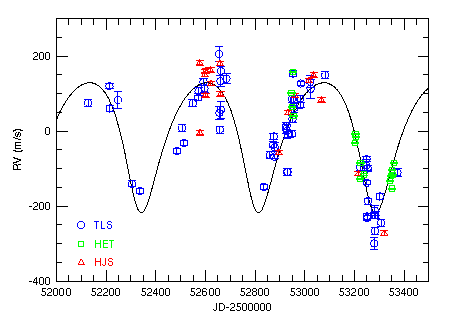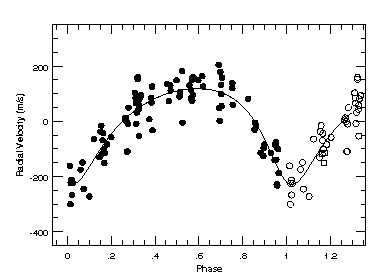A Giant Planet Around The Massive Giant Star HD 13189
The detection of a massive planetary or low mass brown dwarf
companion to the K giant star HD 13189
is based on precise differential radial velocity measurements obtained with the 2.0 m Alfred Jensch telescope
at the
Thueringer Landessternwarte Tautenburg (Germany)
and with the 2.7 m Harlan J. Smith telescope
as well as the Hobby-Eberly Telescope (HET) at McDonald Observatory. The giant status (K2 II) of the host star
makes this discovery exceptional. Based on a comparison with evolutionary tracks we estimate a mass
of the primary between 2 and 7 solar masses. HD 13189 may be the most massive star known to possess an
extrasolar planet. This also demonstrates that planet formation can occur around massive early-type stars.
The projected mass of the companion HD 13189 b ranges from m sin i = 8 to 20 Jupiter masses, depending
on the true mass of the giant star.

Radial velocity data for HD 13189 (K2 II) from the 2.0 m Alfred Jensch telescope at Tautenburg observatory (TLS, blue
circles), the Harlan J. Smith 2.7 m telescope (HJS, red triangles) and the Hobby-Eberly Telescope (HET, green
boxes) at McDonald Observatory. The best-fit Keplerian orbital solution is plotted as a solid black line.
Click for larger image

The HD 13189 Doppler data phased to the orbital period of 472 days (empty circles are repeated data for the
next cycle). The semi amplitude (K) of the signal is
173 m/s. Obviously, there is a large amount of residual scatter around this orbit. This scatter is probably
caused by stellar oscillations, which are typical for K-type giant stars.
Click for larger image
Parameters of the companion and its orbit:
Period = 471.6 ± 6.0 [days]
T periastron = 2452327.9 ± 20.2 [days]
e = 0.27 ± 0.06
omega = 160.7 ± 12.0 [deg]
K = 173.3 ± 9.8 [m/s]
f(m) = (2.26 ± 0.37) x 1.E-07 [solar masses]
M sin i = 8 - 20 M [Jupiter masses] (depending on the mass of the primary)
a = 1.5 - 2.2 [AU]
Parameters of the host star:
Spectral type = K2 II
V = 7.57 [mag]
Hipparcos parallax = 0.54 ± 0.93 mas
M = 2 - 7 M [Sun]
References:
Hatzes A.P., Guenther E., Endl M., Cochran W.D., Doellinger M.P., and Bedalov A.
2005, A&A, accepted
paper (postscript file)
Back to Planetary Systems
webpage by: Michael Endl

